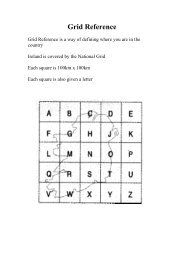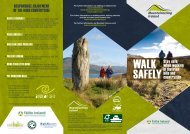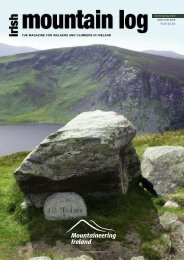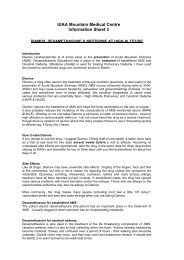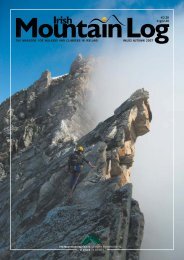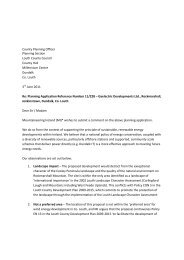Walk Northern Ireland - Mountaineering Ireland
Walk Northern Ireland - Mountaineering Ireland
Walk Northern Ireland - Mountaineering Ireland
You also want an ePaper? Increase the reach of your titles
YUMPU automatically turns print PDFs into web optimized ePapers that Google loves.
Mountains. By joining the Mourne<br />
Trail in Newcastle you can<br />
continue along all the way to<br />
Rostrevor.<br />
The village of Raholp at the start<br />
of the route has strong associations<br />
with St Patrick, <strong>Ireland</strong>’s patron<br />
saint. It’s believed he landed on the<br />
shores of nearby Strangford Lough,<br />
and in 432AD, established <strong>Ireland</strong>’s<br />
first church near Raholp. This is<br />
also one of the highest spots in<br />
Lecale, and on a clear day it makes<br />
a fine vantage point from which to<br />
preview the route ahead.<br />
From Raholp your way lies to the<br />
east, and it’s not long before you<br />
enter the grounds of Castle Ward<br />
Estate. A short detour from the<br />
Above: View of the Mournes<br />
route allows you to take in<br />
Audleystown Cairn, one of the<br />
most important Neolithic sites in<br />
<strong>Northern</strong> <strong>Ireland</strong>. Paths and riding<br />
tracks are then followed past<br />
Audley’s Castle, a fifteenth century<br />
towerhouse, to the grounds of<br />
Castle Ward itself. The grounds of<br />
the estate provide ample walking<br />
opportunity.<br />
The Lecale Way leaves the estate<br />
and winds through pleasant<br />
woodland on the shores of<br />
Castleward Bay towards the village<br />
of Strangford, situated right at the<br />
mouth of Strangford Lough. The<br />
name is derived from the Norse<br />
Strangfjiord, meaning ‘strong fiord’.<br />
Huge swirls, eddies and whirlpools<br />
form as millions of tons of water<br />
are forced through this constricted<br />
passage with every passing tide.<br />
From Strangford the route turns<br />
south and follows the coast towards<br />
Ardglass. The initial section along<br />
the main road is scenic, but you<br />
can take the bus for a few miles if<br />
you want to avoid the traffic.<br />
Quieter lanes then lead past Mill<br />
Quarter Bay and Killard Nature<br />
Reserve before reaching the beach<br />
and village of Ballyhornan. It’s<br />
worth keeping an eye out for<br />
common and grey seals, which are<br />
commonly seen basking on the<br />
rocks. You’re almost certain to spot<br />
cormorants and shags perched on<br />
isolated outcrops with wings<br />
stretched out to dry. And in<br />
summer the coastal meadows are<br />
alive with birds and wild flowers,<br />
including orchids.<br />
Just south of Ballyhornan<br />
Harbour, the Ballyhornan Coastal<br />
Path begins. For much of the way<br />
this is little more than an informal,<br />
grassy path leading along the tops<br />
of the low cliffs and around<br />
secluded coves. There are great<br />
views over Gun Island, which can<br />
be reached on foot at spring low<br />
tides. The island was apparently<br />
named after a cannon from a<br />
shipwreck was washed up on its<br />
shores. This is one of the wildest<br />
stretches of coastline in County<br />
Down and a real pleasure to walk<br />
at any time of year. There is a<br />
palpable sense of isolation, even<br />
though you’re only a few kilometres<br />
walk… Lecale Way<br />
from the nearest village.<br />
The coastal path ends near St<br />
Patrick’s Well, which is marked by a<br />
wooden cross and enclosure. Quiet<br />
roads then lead into Ardglass, a<br />
lovely fishing village founded by<br />
the Normans and still centred<br />
around a deep natural harbour.<br />
Ardglass, or the village of Killough<br />
a short distance further along the<br />
coast, make a perfect place to stop<br />
for the night.<br />
From Killough the Lecale Way<br />
heads south along the Killough<br />
Coastal Path to reach St John’s<br />
Point, resplendent with its striking<br />
black-and-yellow-striped<br />
lighthouse. The route then turns<br />
west past Ringhaddy, Ringboy and<br />
Minerstown, to the beautiful sands<br />
of Tyrella Beach. This is also where<br />
the Mourne Mountains dominate<br />
the views ahead ‘sweeping down to<br />
the sea’, as it says in the famous<br />
Percy French song.<br />
The roads are now left behind<br />
again as you round Dundrum<br />
Inner Bay and head south along the<br />
Dundrum Coastal Path. It’s not far<br />
now to the village of Dundrum,<br />
dominated by de Courcy’s Castle.<br />
The final stage takes you into<br />
Murlough National Nature<br />
Reserve, a 5,000-year-old dune<br />
system of international importance.<br />
There’s a choice of routes through<br />
the reserve; you can either follow<br />
the paths through the extensive<br />
heath and grassland, or stay on the<br />
beach. The reserve is a great place<br />
to visit in its own right for a couple<br />
of hours of walking – see page 23.<br />
The Lecale Way finishes by taking<br />
you along Newcastle Beach, with<br />
the magnificent dome of Slieve<br />
Donard and the promenade of<br />
Newcastle town beckoning you on<br />
to the finish.<br />
The Lecale Way G4–F5<br />
Starting Point: Newcastle<br />
Distance: 43.4km<br />
Maps & Books: ‘Lecale Way: An<br />
Illustrated Guide To <strong>Walk</strong>ing the Lecale<br />
Way’. OSNI sheet: 21/29<br />
www.waymarkedways.com<br />
Facilities: Parking: at Cloghy,<br />
Tyrella, Murlough, Newcastle. Toilets:<br />
Available<br />
discovernorthernireland.com<br />
43






